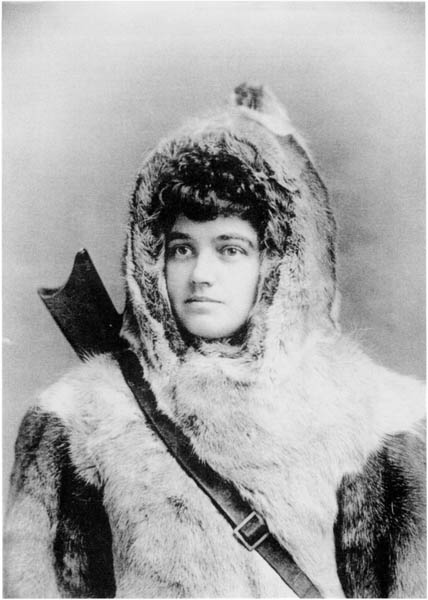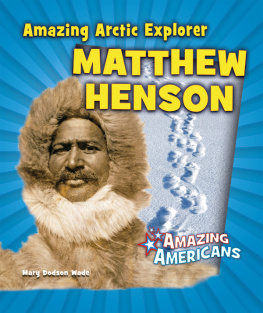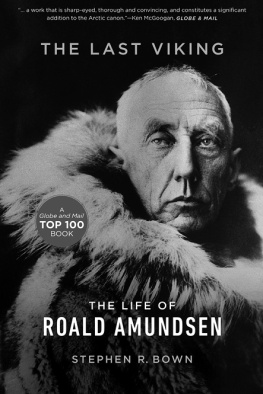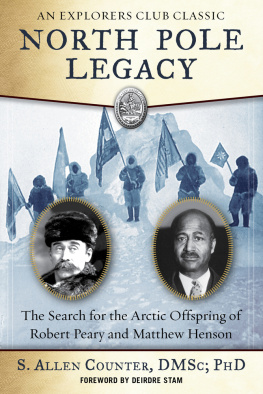MY ARCTIC JOURNAL
A YEAR AMONG ICE-FIELDS AND ESKIMOS
18911892

MY ARCTIC JOURNAL
A YEAR AMONG ICE-FIELDS AND ESKIMOS
18911892
by
Josephine Diebitsch-Peary
WITH AN ACCOUNT OF
THE GREAT WHITE JOURNEY
ACROSS GREENLAND
BY
ROBERT E. PEARY
CIVIL ENGINEER, U.S. NAVY
NEW INTRODUCTION
BY ROBERT M. BRYCE

First Cooper Square Press edition 2002
This Cooper Square Press paperback edition of My Arctic Journal is an unabridged republication of the edition first published in New York in 1893, with the addition of a new frontispiece and a new introduction by Robert M. Bryce.
New introduction copyright 2002 by Robert M. Bryce
All rights reserved.
No part of this book may be reproduced in any form or by any electronic or mechanical means, including information storage and retrieval systems, without written permission.
Published by Cooper Square Press
An Imprint of the Rowman & Littlefield Publishing Group
150 Fifth Avenue, Suite 817
New York, New York 10011
www.coopersquarepress.com
Distributed by National Book Network
Library of Congress Cataloging-in-Publication Data Available
 The paper used in this publication meets the minimum requirements of American National Standard for Information SciencesPermanence of Paper for Printed Library Materials, ANSI/NISO Z39.481992.
The paper used in this publication meets the minimum requirements of American National Standard for Information SciencesPermanence of Paper for Printed Library Materials, ANSI/NISO Z39.481992.
Manufactured in the United States of America.
ISBN: 978-0-8154-1198-7
INTRODUCTION TO THE
COOPER SQUARE PRESS EDITION
By the standards of her day, Josephine Diebitsch-Peary led a very unusual life. As with most unusual lives, hers was the product of an unusual ambition. Although, like many Victorian women, it was her husbands ambition and not her own, her desire to be an active participant in its realization was what brought her to wider notice.
Josephine Diebitsch was born to German immigrant parents on May 22, 1863 in Washington, D.C. Her father was head of the interlibrary exchange at the Smithsonian Institution and Josephine became his assistant. At nineteen she met Robert E. Peary, a civil engineer in the U.S. Navy. Even their meeting was a product of Pearys budding ambition.
Peary had once been engaged to a hometown girl, but broke off the engagement when he moved to Washington to take up his appointment as a draftsman for the Coast and Geodetic Survey. After obtaining his Navy commission through a competitive exam, he aimed to rise high in Washington society and to make powerful friends. A product of provincial Maine, he made a conscious study of improving his social graces, including a course in ballroom dancing. It was at a dance that he met Miss Diebitsch in 1882. This encounter began a six-year courtship, interrupted by journeys in quest of Pearys fondest desire: fame and an honorable name that would make him known throughout the world.
At first, he hoped to find both in connection with his work on the survey of a route for the Trans-Isthmian Ship Canal across Nicaragua. Then Peary became interested in Greenlands unexplored ice cap, which he penetrated 100 miles in 1886 on a self-financed excursion. When he had to return to Nicaragua in 1887, he debated what he should do about Jo: That she loves me I know; that she can make me happy I think; that she would hamper me less than any woman I have met or am likely to meet I am confident. [Still] I shrink from voluntarily chaining myself; & have to submit my last & fairest dream to the cold light of prosaic daily life. Nevertheless, before Peary left, he proposed, and they were married after his return, on August 11, 1888. They honeymooned in Seabright, New Jersey. Pearys overprotective mother accompanied them. Jo naturally resented this intrusion and ever after felt herself second in Berts affections.
Peary was assigned to the New York Naval Shipyard. The couple set up housekeeping, first on Madison Avenue, then in a boardinghouse on 32nd Street. Jo was helplessly in love with the man whom she thought could not be more handsome, and believed that, if not ahead of his mother, she at least stood ahead of Berts ambition. Bert puts the Canal aside, she wrote to her mother, and devotes the whole time to me, and if he is as happy as I am, then we are the happiest people in the world.
But he was not. Prosaic daily life soon lost its novelty; the old yearning for fame only lay dormant for awhile.
With the abandonment of the Nicaraguan canal route for one across Panama, the southern pathway to fame closed to him. Pearys thoughts turned north again. He began to promote an expedition, the object of which would be the crossing of Greenlands ice cap. When Norwegian explorer Fridtjof Nansen accomplished this feat, Peary proposed a survey of Northern Greenland to determine its extent in the direction of that much-coveted exploratory goal, the North Pole (Pearys own secret ambition). But for the time being, this ultimate destination remained only a dream, one that caused him many periods of self-doubt and despair.
In 1890, Pearys fortune changed when he was transferred to the League Island Naval Yard in Philadelphia. A lecture on his proposed expedition gained him the attention and support of the Academy of Natural Sciences of Philadelphia. Suddenly, it seemed as if his dreams might be within his grasp: Fame, money & revenge goad me forward till sometimes I can hardly sleep with anxiety lest something happen to interfere with my plans, he confided to his mother.
Peary worked tirelessly, putting his expedition together on a shoestring and obtaining a leave of absence from his naval duties to execute his plans. He engaged young, eager amateurs as assistants and took care to hire no potential rival for attention or for credit upon his return. But as the expedition prepared to sail from Brooklyn on June 6, 1891, the center of attention was not Robert Peary, but his wife, who would be going as well.
The newspapers vacillated between condemning Robert Peary for exposing his young wife to the dangers of the frigid north, which had claimed many a hardy man, and commending Josephine Peary for her loyalty in agreeing to accompany her husband. The large crowd on the dock to see the Kite off was anxious to get a glimpse of this brave woman bound for the icy Sahara.
My Arctic Journal, first published in 1893, is just that: a record of Jo Pearys experiences on her husbands North Greenland Expedition of 18911892. During research for my book, Cook & Peary: The Polar Controversy, Resolved, I always sought primary sources, including accounts by participants in the events that I wished to portray. Jo Pearys book was readily at hand, but I wondered how much of it reflected her actual experiences and feelings. Although complete diaries of some other expedition members were easily located in the vast Peary Family Collection housed at the National Archives, only parts of Mrs. Pearys diary could be found there. Promising leads in New England turned up none of the missing portions. However, a comparison of what survives shows that many important passages in her booksuch as her description of the accident that broke her husbands leg on the way to Greenlandare reproduced from her original diary nearly verbatim. Of course, a large amount of material has been edited out: chiefly commonplaces, annoyances, and statements of a personal nature. But because Jo was unable to abandon completely her Victorian notions of cleanliness, civilization, and proprietymuch less come to any real understanding of the strange little brown people she encountered in the Inuit, who flocked to see the wonders of the white mens house








 The paper used in this publication meets the minimum requirements of American National Standard for Information SciencesPermanence of Paper for Printed Library Materials, ANSI/NISO Z39.481992.
The paper used in this publication meets the minimum requirements of American National Standard for Information SciencesPermanence of Paper for Printed Library Materials, ANSI/NISO Z39.481992.